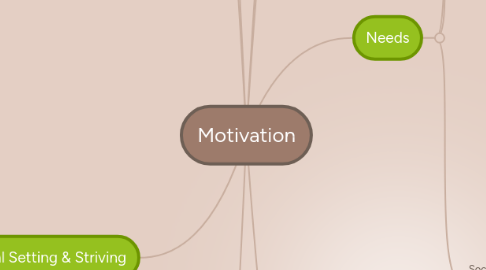
1. External
1.1. External
2. Spectrum
2.1. Extrinsic
2.1.1. External
2.1.1.1. Punishment
2.1.1.2. Rewards
2.1.1.2.1. Expected Vs. Unexpected
2.1.1.2.2. Tangible Vs. Verbal
2.2. Intrinsic
2.2.1. Internal
2.3. Regulation
2.3.1. Introjected
2.3.1.1. Somewhat Internal
2.3.2. Identified
2.3.2.1. Somewhat External
2.3.3. Integrated
2.3.3.1. Internal
3. Goal Setting & Striving
3.1. Self Regulation
3.1.1. Feedback System
3.2. Discrepencies
3.2.1. TOTE Model
3.2.2. Reduction
3.2.3. Creation
3.3. Consistent Self Concept
3.3.1. Cognitive
3.3.1.1. Know Onself
3.3.2. Epistemic
3.3.2.1. Predictability
3.3.3. Pragmatic
3.3.3.1. Avoid Surprise
3.4. Short Term Goal Setting
3.4.1. S.M.A.R.T
3.4.1.1. Specific
3.4.1.2. Measurable
3.4.1.3. Attainable
3.4.1.4. Relevant
3.4.1.5. Time Sensative
3.4.2. Difficulty
3.4.3. Feedback
3.4.4. Acceptance
3.5. Long Term Goals
3.5.1. Personal
3.5.2. Goals & Identity
3.5.2.1. The Self
3.5.2.1.1. Self Concordance
3.5.2.2. Self Dissonance
3.5.2.3. Sources
3.5.2.3.1. Values
3.5.2.3.2. Needs
3.5.2.3.3. Callings
3.6. Unconscious Goal Pursuit
3.6.1. Psychodynamic
3.6.1.1. Freud
3.6.1.2. Mental Arena
3.6.2. Priming
3.6.3. Situation Cues
3.6.3.1. Habitualized Behavior
3.6.4. Automatic Goals
3.6.4.1. Maintain The Self
3.6.4.2. Streotyping Activation
3.7. Planning
3.7.1. Visualization
3.7.1.1. Outcome - Detrimental
3.7.1.2. Process - Beneficial
3.7.1.2.1. Implementation Intention
3.8. Persistence and Shift
3.8.1. Unattainable Goals
3.8.1.1. WASSUP
3.8.2. Presistence
3.8.2.1. Present In Working Memory
3.8.2.2. Requires Feedback
3.8.3. Disengagement
3.8.3.1. Cognitive
3.8.3.1.1. Clearance of Working Memory
3.8.3.2. Afffective
3.8.3.2.1. Down Regulation of Emotions
3.8.3.3. Behavioral
3.8.3.3.1. New Activites
3.8.3.4. Low Levels
3.8.3.4.1. High Stress
3.8.3.5. High Levels
3.8.3.5.1. Low Stress
3.9. Goal Shift
3.9.1. New Goal
3.9.1.1. Not Goal Modification
4. New node
5. Influence
6. Biology
6.1. Arousal
6.1.1. Sensation Seeking
6.2. Brain Generated
6.2.1. BAS
6.2.2. BIS
7. Needs
7.1. Physiological
7.1.1. Food, Air, Etc.
7.2. Psychological
7.2.1. Self Determination Theory
7.2.1.1. Relatedness
7.2.1.1.1. Interaction
7.2.1.2. Competence
7.2.1.2.1. Flow
7.2.1.3. Autonomy
7.2.1.3.1. Volition
7.2.1.3.2. Agency
7.2.1.3.3. Perceived LOC
7.2.1.4. Cognitive Evaluation Theory
7.2.1.4.1. Perceived Locus of Causality
7.2.1.4.2. Controlling vs Informational
7.2.2. Hierarchy of Needs
7.2.2.1. Physiological >>> Self Actualization
7.2.3. Organismic
7.3. Social
7.3.1. Affiliation
7.3.1.1. Need Involving
7.3.1.1.1. Social Deprvation
7.3.1.2. Need Satisfying
7.3.1.2.1. Social Acceptance
7.3.2. Intimcacy
7.3.2.1. Need Involving
7.3.2.1.1. Interpersonal Care
7.3.2.2. Need Satisfying
7.3.2.2.1. Warm Close Relationship
7.3.3. Power
7.3.3.1. Impact
7.3.3.2. Control
7.3.4. Achievement
7.3.4.1. Competition
7.3.4.1.1. Vs. Task
7.3.4.1.2. Vs. Self
7.3.4.1.3. Vs. Others
7.3.4.2. Goals
7.3.4.2.1. Mastery
7.3.4.2.2. Performance
7.3.4.2.3. Approach & Avoidance
8. Personal Control Beliefs
8.1. Implicit Theories
8.1.1. Growth Mindset
8.1.2. Fixed Mindset
8.1.3. Efficacy Expectations
8.1.3.1. Personal Behavior History
8.1.3.2. Vicarious Experience
8.1.3.3. Verbal Pesuasion
8.1.3.4. Physiological Activity
8.1.4. Outcome Expectation
8.1.4.1. Internal & External LOC
8.1.5. Explanatory Style
8.1.5.1. Optimistic
8.1.5.1.1. Unstable & Controllable
8.1.5.2. Pessamistic
8.1.5.2.1. Stable & Uncontrollable
8.1.6. Hope
8.1.6.1. Agentic Thinking
8.1.6.2. Pathways Thinking
